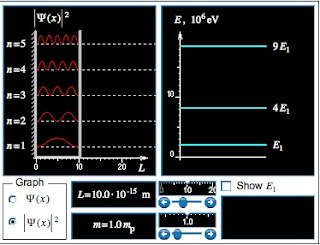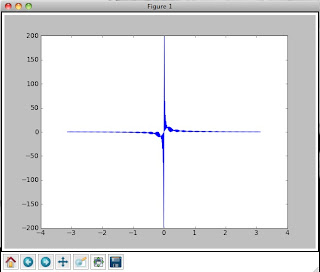From your study of mechanical waves, what is the longest wavelength standing wave on a string of length L?
A: The longest wavelength would be 2L.
Question 2: The de Broglie Relation
What is the momentum of the longest wavelength standing wave in a box of length L?
A: Using de Broglie's equation p=h/2L.
Question 3: Ground State Energy
Assuming the particle is not traveling at relativistic speeds, determine an expression for the ground state energy.
Assuming the particle is not traveling at relativistic speeds, determine an expression for the ground state energy.
Check your result by displaying the ground state energy.
A: E= (h^2)/8mL
If the size of the box is increased, will the ground state energy increase or decrease?
A: As the size of the box increases the ground state energy decreases.
Question 5: The Correspondence Principle: Large Size
In the limit of a very large box, what will happen to the ground state energy and the spacing between allowed energy levels? Can this result explain why quantum effects are not noticable in everyday, macroscopic situations?
In the limit of a very large box, what will happen to the ground state energy and the spacing between allowed energy levels? Can this result explain why quantum effects are not noticable in everyday, macroscopic situations?
A: As the ground state energy gets smaller the spacing becomes continuous.
Question 6: The Correspondence Principle: Large Mass
In the limit of a very massive particle, what will happen to the ground state energy and the spacing between allowed energy levels?
In the limit of a very massive particle, what will happen to the ground state energy and the spacing between allowed energy levels?
A: With and increase in the mass we have a decrease in ground state energies.
If a measurement is made of the particle's position while in the ground state, at what position is it most likely to be detected?
A: At its ground state a particle is most likely to be in the center.
Question 8: Probability: Dependence on Mass and Size
The most likely position to detect the particle, when it is in the ground state, is in the center of the box. Does this observation depend on either the mass of the particle or the size of the box?
A: No, if the mass of the particle or the size of the box increase in the ground state energy the electron is still most likely to be found in the center.
Question 9: Probability: Dependence on Energy Level
The most likely position to detect the particle, when it is in the ground state, is in the center of the box. Does this observation hold true at higher energy levels?
A: Yes even if energy levels are higher the particle is still most likely in the center of the box.
Question 10: The Correspondence Principle: Large n
In the limit of large n, what will happen to the spacing between regions of high and low probability of detection? Does this agree with what is observed in everyday, macroscopic situations?
A: At a high n the spacing between the nodes gets closer and closer tell the energy becomes continuous.








